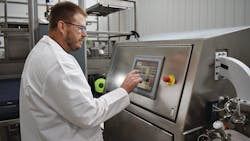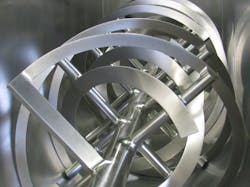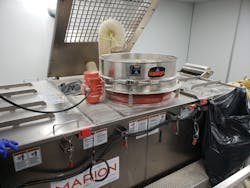Seamless integration: Executing effective mixing line upgrades
The COVID-19 pandemic has placed a considerable strain on the global supply chain, disrupting the flow of raw materials and finished goods and creating labor shortages. In such an uncertain climate, maximizing the performance and efficiency of a processing line is key to a sustainable business model. Exploring all available equipment options is critical to meeting emergent challenges and being positioned to take advantage of future business goals and expansion opportunities.
This article explores the most common root objectives for mixer line upgrades. Whether an organization is refreshing and retrofitting older equipment, switching up production machinery to meet current industry standards and consumer demands, or redesigning processing lines with an eye on competitive advantage, the following considerations can help maximize production efficiency.
Updating to contend with outdated, difficult-to-maintain equipment
The most common reason for mixing line changes or expansions is the desire to boost capacity while reducing downtime. Operations using grandfathered mixing equipment may see more frequent mix rejections as time wears on. Even if the product meets quality standards, outdated mixing and blending equipment can create inefficiencies that ultimately impact processing time and capacity. Bottlenecks caused by older equipment can include increased downtime, longer changeover and sanitation and maintenance challenges.
Regardless of the specific issues posed by grandfathered mixing equipment, the decision to update a line ultimately comes down to effective reporting and a thorough assessment of the long-term impacts of executing a line upgrade.
First and foremost, perform a capacity evaluation if it is not already a standard performance metric. What is current capacity and utilization? How has this changed over time? How often has a line performed at or beyond capacity?
For best results and to ensure that data is as accurate as possible, take the time to consult with original equipment manufacturers or authorized sales representatives during this process. Leverage their industry expertise and processing knowledge to optimize current equipment capacities and understand thresholds.
Next, take the time to assess the factors currently impacting capacity — and not just those directly associated with the production process. While workers “on the line” can readily provide feedback on routine maintenance, cleanout and changeover, exploring other interdepartmental challenges and insights may provide information that proves critical in the decision-making process. Procurement personnel can provide expertise on material costs, changes to size or texture and other factors that will impact capacity. Similarly, an organization’s sales team can advise on the latest industry trends, possible opportunities for new business, and the challenges presented by both.
Adapting to respond to changing industry standards and consumer demands
External forces can also trigger the need for a line upgrade. A mix made the same way for years can suddenly change, presenting challenges to existing equipment. Industry or consumer expectations for a product shift in response to emergent market trends. Certification requirements and standards continue to develop and expand over time, leaving a current process out of spec. Such outside factors may require a quick response but can be planned for in a mixing line upgrade.
Whatever the new requirement or standard, a team should have full understanding of what it entails and its impact on operations. Look to the organization's internal tribal knowledge for help in adapting an existing process. Capacity evaluation will again play a critical role, as will institutional knowledge.
External collaboration is also vital to the success of a line upgrade. Tap into resources such as sales representative networks. Sales agents have extensive industry experience and vendor knowledge that can help with even the most daunting application challenges. A standard operating procedure that they helped orchestrate for an existing installation may be applicable to your process.
If a line change is driven by changing requirements or certifications, this will also be an excellent time to examine not just internal operations and application needs, but broader industry and consumer trends as well.
Innovating to gain a competitive edge while addressing current and future challenges
The last main impetus for a mixing line update is the desire to not only react to current processing issues but be ahead of the curve and plan for tomorrow's challenges. This will ensure that the line upgrade is proactive in nature.
In a time when sustainability is key, why not look to cutting-edge, innovative processing equipment that goes beyond the minimum requirements? Explore how equipment retrofits or replacement can not only boost production capacity, but also reduce energy consumption, provide more efficient processing and produce less dust or waste.
With record labor shortages, businesses are increasingly searching for more automated processing solutions. Consider the overhead costs of a machine’s performance and examine the time and effort that goes into its operation, maintenance and upkeep.
Take the time to research the latest developments in mixing technology that promote ergonomics, easy operation, reduced product loss, increased operator safety and more uniform mixes.
Also explore mixing equipment that provides flexibility and is made for easy adaptation, integration and expansion down the road. Business operations are not stagnant, and the same should be said for processing equipment. A mixing line change should not only offer an updated solution designed to adapt to current needs, but also allow a company to meet and adapt to future challenges with ease.
Additionally, consider how other types of processing equipment can help optimize mixing operations. Powdered nutraceutical and tablet pressing applications, for example, can benefit from vibratory or centrifugal sifters pre- or post-mixing to provide consistently high-quality and precise mixes. Similarly, size reduction equipment, such as lump breakers, can be used before or after mixing to mechanically break down agglomerates and grind solids down to a maximum particle size to achieve a narrow particle size distribution. Innovative thermal processing equipment can also be used to handle heat-sensitive materials or provide a combination of mixing and temperature or moisture control.
Planning for today and tomorrow
Whether a mixing line upgrade is prompted by internal need, external demand or futureproofing, consider the following suggestions to ensure a smooth transition.
- Have a clear definition of how much increased capacity your line can handle and what it would take to improve.
- Consider additional process solutions that might not be needed currently but should be planned for to ensure seamless integration when the timing is right. A mixing line that allows for future retrofitting can provide a more seamless integration down the road.
- Product testing and trial equipment is critical to ensure that an upgrade will meet current and future processing needs. Many reputable equipment suppliers offer on-site or lab testing for new process solutions that can help prove capacity or processing gains.
- Look beyond mixing equipment when considering mixing line upgrades. Understand how upstream or downstream processing equipment can help provide a more consistent end product, increased automation and reduced product loss and contamination.
Ultimately, the decision to expand, replace and optimize an existing mixing line should have a clear end goal that begins with a single step forward. No matter the reason, map out a clear route to ensure a successful line upgrade that will benefit your operations for decades to come.
Lance Briggs is VP of sales and business development for Advanced Material Processing (AMP), parent company of Marion Process Solutions. He leads the commercial efforts for North America across AMP's complete solution platform.
Marion Process Solutions
About the Author
Lance Briggs
Vice President of Sales and Business Development for Advanced Material Processing
Lance Briggs is vice president of sales and business development at Advanced Material Processing, parent company of Marion Process Solutions.


